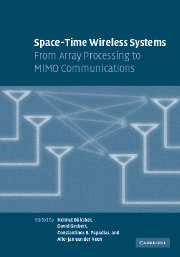Book contents
- Frontmatter
- Contents
- List of contributors
- Acknowledgments
- Introduction
- Part I Multiantenna basics
- Part II Space-time modulation and coding
- Part III Receiver algorithms and parameter estimation
- Part IV System-level issues of multiantenna systems
- Part V Implementations, measurements, prototypes, and standards
- Index
Introduction
Published online by Cambridge University Press: 25 February 2010
- Frontmatter
- Contents
- List of contributors
- Acknowledgments
- Introduction
- Part I Multiantenna basics
- Part II Space-time modulation and coding
- Part III Receiver algorithms and parameter estimation
- Part IV System-level issues of multiantenna systems
- Part V Implementations, measurements, prototypes, and standards
- Index
Summary
The MIMO wireless success story
Wireless products in all shapes and sizes penetrate our offices, homes, and pockets. Despite the bursting of the dot-com bubble, the wireless communications industry has seen significant growth in the past decades and has become an essential part of our lives. Among the technologies with a chance to resolve the bottlenecks in traffic capacity likely to occur in many of the future wireless networks, few are as promising as multiple-input multiple-output (MIMO) technology and space-time processing.
This chapter serves as a brief introduction to MIMO wireless and spacetime processing, with the aim of providing the reader with a perspective on historical and recent progress in this rapidly evolving field of communications research. A taxonomy of the various branches of study in MIMO wireless is provided, pointing to the remaining chapters in this book, which address the corresponding areas in greater detail.
The popularity of MIMO wireless systems is, by all measures, staggering. MIMO technology constitutes one of the rare cases in wireless communications where the full cycle of developing ideas on the blackboard, experimental verification, integrated circuits, standards, and, finally, commercially available products has been completed within a decade. This success is further accentuated by the synergy brought about between researchers in information and coding theory, signal processing, propagation theory and antenna design, VLSI, physics, and applied mathematics.
- Type
- Chapter
- Information
- Space-Time Wireless SystemsFrom Array Processing to MIMO Communications, pp. xxi - xxxiiPublisher: Cambridge University PressPrint publication year: 2006



